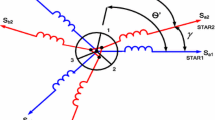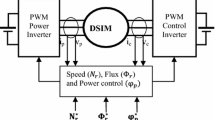Abstract
This paper proposes an optimal vector control strategy to minimize copper losses and to improve the power factor and the efficiency of a multiphase induction machine drive system. Indeed, the proposed approach aims to minimize the magnetizing energy by adjusting the magnetic state of the motor regarding the drive’s operating point. As a result, the current circulating through the motor windings can be reduced, which leads to copper losses reduction. Hence, an improvement in the machine’s power factor and efficiency is obtained. Simulation and experimental results are carried out on a drive system based on a dual star induction machine to validate the proposed control approach.












Similar content being viewed by others
References
Levi E (2008) Multiphase electric machines for variable-speed applications. IEEE Trans Ind Electron 55(5):1893–1909
Barrero F, Duran MJ (2016) Recent advances in the design, modeling, and control of multiphase machines part I. IEEE Trans Ind Electron 63(1):449–458
Duran MJ, Barrero F (2016) Recent advances in the design, modeling, and control of multiphase machines part II. IEEE Trans Ind Electron 63(1):459–468
Marouani K, Nounou K, Benbouzid M, Tabbache B (2018) Investigation of energy-efficiency improvement in an electrical drive system based on multi-winding machines. Electr Eng 100(1):205–216
Klingshirn EA (1983) High phase order induction motors—part I: description and theoretical consideration. IEEE Trans Power Appar Syst 102:47–53
Marouani K, Baghli L, Hadiouche D, Kheloui A, Rezzoug A (2008) A new PWM strategy based on a 24-sector vector space decomposition for a six-phase VSI-fed dual stator induction motor. IEEE Trans Ind Electron 55(5):1910–1920
Melo VFMB, Jacobina CB, Rocha N (2017) Fault tolerance performance of dual-inverter-based six-phase drive system under single-two-, and three-phase open-circuit fault operation. IET Power Electron 11(1):212–220
Marouani K, Nesri M, Nounou K (2016) Rotor flux control with copper losses reduction in a high power drive system. In: IEEE international power electronics and motion control conference (PEMC’2016)
Negahdari A, Yepes AG, Doval-Gandoy J, Toliyat H (2018) Efficiency enhancement of multiphase electric drives at light-load operation considering both converter and stator copper losses. IEEE Trans Power Electron 34:1518–1525
Boglietti A, Bojoi R, Cavagnino A, Tenconi A (2008) Efficiency analysis of PWM inverter fed three-phase and dual three-phase high frequency induction machines for low/medium power applications. IEEE Trans Ind Electron 55(5):2015–2023
Bodo N, Levi E, Subotic L, Espina J, Empringham L, Johnson CM (2017) Efficiency evaluation of fully integrated on-board EV battery chargers with nine-phase machines. IEEE Trans Energy Corners 32(1):257266
Lai JS, Yu W, Sun P, Leslie S, Arnet B, Smith C, Cogan A (2014) A hybrid-switch-based soft-switching inverter for ultrahigh-efficiency traction motor drives. IEEE Trans Ind Appl 50(3):1966–1973
Lipo TA (1980) A dq model for six phase induction machines. In: Proceedings of ICEM’80, pp 860–867
Vas P (1998) Sensorless vector and direct torque control. Oxford University Press, Oxford
Zhao Y, Lipo TA (1995) Space vector PWM control of dual three phase induction machine using vector space decomposition. IEEE Trans Ind Appl 31(5):1100–1109
Abbas MA, Christen R, Jahns TM (1984) Six-phase voltage source inverter driven induction motor. IEEE Trans Ind Appl 5:1251–1259
Boukhelifa A (2007) Optimization elements for controlling an asynchronous machine for vector control. PhD Thesis, National Polytechnic School, Algiers, Algeria (in French)
Author information
Authors and Affiliations
Corresponding author
Additional information
Publisher's Note
Springer Nature remains neutral with regard to jurisdictional claims in published maps and institutional affiliations.
Appendix
Rights and permissions
About this article
Cite this article
Nesri, M., Nounou, K., Marouani, K. et al. Efficiency improvement of a vector-controlled dual star induction machine drive system. Electr Eng 102, 939–952 (2020). https://doi.org/10.1007/s00202-020-00924-9
Received:
Accepted:
Published:
Issue Date:
DOI: https://doi.org/10.1007/s00202-020-00924-9




